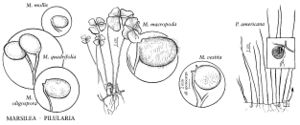Difference between revisions of "Marsileaceae"
FNA>Volume Importer |
FNA>Volume Importer |
||
| Line 18: | Line 18: | ||
|distribution=Nearly worldwide;temperate and tropical regions. | |distribution=Nearly worldwide;temperate and tropical regions. | ||
|discussion=<p>Spore germination in the family occurs after rupture of the sporocarp wall allows the sporocarp contents to be hydrated. A gelatinous structure emerges from the sporocarp, breaking it into valves and carrying the sori into the water. Spore germination (gametophyte growth) and fertilization occur immediately.</p><!-- | |discussion=<p>Spore germination in the family occurs after rupture of the sporocarp wall allows the sporocarp contents to be hydrated. A gelatinous structure emerges from the sporocarp, breaking it into valves and carrying the sori into the water. Spore germination (gametophyte growth) and fertilization occur immediately.</p><!-- | ||
| − | --><p>Regnellidium diphyllum Lindman was introduced into a wildlife pond in Mahoning County, Ohio, in 1985 and continues to persist (C. F. Chuey, in litt. 1991). Regnellidium is similar to Marsilea but differs from it in having two leaflets instead of four.</p><!-- | + | --><p>Regnellidium diphyllum Lindman was introduced into a wildlife pond in Mahoning County, Ohio, in 1985 and continues to persist (C. F. Chuey, in litt. 1991). Regnellidium is similar to <i>Marsilea</i> but differs from it in having two leaflets instead of four.</p><!-- |
--><p>Genera 3, species ca. 50 (2 genera, 7 species in the flora).</p> | --><p>Genera 3, species ca. 50 (2 genera, 7 species in the flora).</p> | ||
|tables= | |tables= | ||
| Line 61: | Line 61: | ||
|publication year= | |publication year= | ||
|special status= | |special status= | ||
| − | |source xml=https://jpend@bitbucket.org/aafc-mbb/fna-data-curation.git/src/ | + | |source xml=https://jpend@bitbucket.org/aafc-mbb/fna-data-curation.git/src/8f726806613d60c220dc4493de13607dd3150896/coarse_grained_fna_xml/V2/V2_101.xml |
}}<!-- | }}<!-- | ||
-->[[Category:Treatment]] | -->[[Category:Treatment]] | ||
Revision as of 15:45, 18 September 2019
Plants aquatic or amphibious, rhizomatous. Stems growing on soil surface or subterranean, main stem long-creeping and giving rise to long or short shoots only at nodes; hairs laterally attached, multicellular. Roots arising at nodes and also along internodes. Leaves distichous, long-petioled, sometimes filiform and lacking expanded blades. Sori within hard bean- or pea-shaped bodies (sporocarps) arising on short stalks from near or at base of petioles. Sporangia of 2 kinds, borne within the same sorus and sporocarp; megasporangia containing a single megaspore; microsporangia containing 20–64 microspores. Gametophytes remaining within spores; microgametophytes of only a few cells; megagametophytes protruding from spores, each bearing 1 simple archegonium.
Distribution
Nearly worldwide, temperate and tropical regions.
Discussion
Spore germination in the family occurs after rupture of the sporocarp wall allows the sporocarp contents to be hydrated. A gelatinous structure emerges from the sporocarp, breaking it into valves and carrying the sori into the water. Spore germination (gametophyte growth) and fertilization occur immediately.
Regnellidium diphyllum Lindman was introduced into a wildlife pond in Mahoning County, Ohio, in 1985 and continues to persist (C. F. Chuey, in litt. 1991). Regnellidium is similar to Marsilea but differs from it in having two leaflets instead of four.
Genera 3, species ca. 50 (2 genera, 7 species in the flora).
